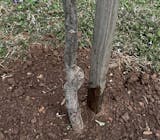
Schoolhouse European Plum
Prunus domestica 'Schoolhouse'
A large, oval, bright yellow plum with a mild, satisfying flavor and a nice, firm bite. It appears to be a late-ripening, prune-type plum, but its bright yellow color makes it unique. The firm texture makes it especially well-suited for freezing and canning. It is named for the schoolhouse where it was found in Pt. Townsend, Washington by James Fritz.
Extremely productive and reliable. Fruits may need thinning to keep branches from breaking under the heavy plum loads. Needs a pollinizer.
USDA Zone: 5-9
Grow Height: 12'
Sun: Full Sun
Ripening Time: September
Pollination: Needs a Pollinizer
Rootstock: C115 - St. Julian, C115A - Marianna 2624, C115D - Krymsk-1
Read our Plum Growing Guide






